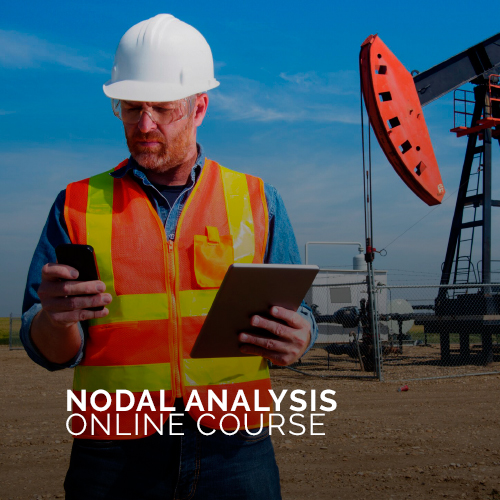
NODAL ANALYSIS DEFINITION
Nodal Analysis is a technique that allows determining the state of a well (production or injection) by the analysis of two subsystems: “Inflow” (upstream or supply) and “outflow” (downstream or demand) defined by a “Node” (reference point).
Nodal Analysis not only allows to determine but also visualize the well response for a given conditions, which helps to recognize the suitable characteristics or limitations for the production scheme. Having just the expected production without the nodal analysis plots does not allow to identify the current situation, the opportunities, and threats.
The flow of reservoir fluids from the subsurface reservoir to the stock tank or sales line requires an understanding of the principles of fluid PVT properties, fluid flow through porous media, well tubulars artificial lift equipment, choke constrains, etc. As the fluid moves through the production system, there will be an associated pressure drop to accompany the fluid flow. This pressure drop will be the sum of the pressure drops through the various components in the production system. Due to the compressible nature of the fluids produced in oil and gas operations, the pressure drop is dependent on the interaction between the various components in the system. This occurs because the pressure drop in a particular component is not only dependent on the flow rate through the component, but also on the average pressure that exists in the component.
As a result, the final design of a production system requires an integrated approach. The amount of oil and gas produced from the reservoir to the surface depends on the total pressure drop in the production system, and the pressure drop in the system depends on the amount of fluid flowing through the system. Consequently, the entire production system must be analyzed as a unit or system.
Nodal analysis is a great tool for petroleum engineers but before using it, it is important to know when can be applied and when cannot be applied. Nodal Analysis allows to determine the expected rate or no flow condition for a given set of reservoir and well conditions (Reservoir Pressure, Productivity Index, Skin damage, water percentage, GOR, tubing ID, perforations depth, choke size, flowline diameter and length, separator pressure, etc) as input parameters, but nodal analysis cannot predict what and when these parameter will reach a value.
Also we can combine additional information, by considering the critical rate (for water/gas coning or sand production) the Nodal Analysis allows to determine the corresponding pressures through the production system for avoiding the sand production or water/gas coning. For example, knowing the flocculation pressure the Nodal Analysis allows to determine where the asphaltene flocculation or paraffin solidification takes place and the corresponding rates, in this way we can avoid asphaltenes plugging the porous media in the near wellbore which requires expensive damage removal stimulations with coil tubing job. To predict flocculation pressure is beyond the nodal analysis, for this purpose a PVT simulator with advanced equation of state is required fed with the molar composition of the oil as well as many lab tests.
Nodal Analysis allows to evaluate performance for a given solution, for example what will be the production increase if we install Artificial Lift. However, nodal analysis is not going to provide the solutions (ESP, PCP, or install a bigger tubing, acid stimulation, etc.)
A single nodal analysis in one well cannot tell the reservoir dynamics, however, when integrating nodal analysis with reservoir simulation more reliable and precise production profiles can be obtained. Reservoir simulations perform nodal analysis when vertical lift performance curves are provided.
Probably the most common mistake using nodal analysis is to apply this method in wells in transient or instable conditions such as heading, severe slugging, starting, unloading, acidicing operations, etc. Nodal analysis can be applied only in wells having steady or pseudo steady state conditions.
In a production system the separator pressure is fixed by a control pressure system, and the separator was designed by process engineers to work at a constant value. On the other hand, the reservoir static pressure (at reservoir limits) changes if there is not reservoir pressure maintenance injection programs and/or recovery program. Usually reservoir pressure changes take few years to see a significant variation; for the daily operations and production engineering purposes the reservoir pressure could be considered constant for some months. In contrast at any other location, such bottom hole, tubing head, the pressure can change in matter of hours depending on the flowing conditions.
Systems analysis is based on the concept of continuity. At any given point in the production system, there is a particular pressure and production rate associated with that point for a set of conditions. If there is any change in the system, then there will be an associated change in pressure and/or production rate at that same point. This concept allows the production system to be divided at a point of interest for evaluation of the two portions of the system. This evaluation determines the conditions of continuity of pressure and production rate at the division point, which is the estimated producing condition for the system being evaluated.
The approach provides the flexibility to divide the production system at any point of interest within the system to evaluate a particular component of the system. The most common division points are at the wellhead or at the perforations, either at the reservoir sandface or inside the wellbore. The terminal ends of the system will be the reservoir on the upstream end of the system and the separator at the downstream end of the system or the wellhead if a wellhead choke controls the well.
INFLOW
The components upstream of the division point or node defines the system’s inflow while the components downstream of the node represent the system’s outflow. Once the system is divided into inflow and outflow sections, relationships are written to describe the rate-pressure relationship within each section. The flow rate through the system is determined once the conditions of continuity are satisfied:
When the node is at the bottom hole it allows to analyze the system into Reservoir Inflow performance Relationship (IPR) and the production system which is very convenient form reservoir and production engineers because of their duties and expertise. Production engineers can focus on how to improve the production system while visualizing if the reservoir has a limitation or problem, and vice versa for the reservoir engineers
Clearly when the bottom hole flowing pressure is equal to the reservoir pressure there is no flow.
The lower the Pwf the higher the rate Q. From the hydraulic point of view the most favorable condition for the reservoir to maximize the rate is at Pwf=0 or Absolute Open Flow (AOF) However, from water/gas conning or sand production point of view the AOF probably is not the best choice.
All the variables that are related with the upstream affects the Inflow performance.
INFLOW IPR MODELS
The reservoir performance depends on: Reservoir Pressure, Bubble Pressure (which defines multi or single phase zones), Productivity Index PI (BPD/PSI). The PI can be calculated from the permeability K, reservoir thickness h, fluid viscosity μ, volumetric factor B, drainage radius Re, Wellbore radius Rw and Skin Factor S. The best way of obtaining these parameters is with a buildup test. However, they cannot be taken so frequently because it implies production deferment
PI also can be estimated by matching production data through tuning the PI value when having Production test Q test and its corresponding bottom hole flowing pressure Pwf test.
There have been numerous empirical relationships proposed to predict oil well performance under two-phase flow conditions. The most widely used methods are:
The linear or Darcy type IPR which is an straight line with slope = -1/PI (The higher the PI the more horizontal the line, the negative sign means the lower the Pwf the higher the rate as expected). Some of the key methods are described below.
The Vogel’s IPR. This empirical inflow performance relationship (IPR) is based on fitting computer simulation results with a second-degree polynomial.
The composite IPR that couples Vogel’s IPR for two-phase (flow for Pwf below bubble point with the single-phase productivity index for Pwf above the bubble point).
By using the IPR models the production engineers have an acceptable accuracy for their purpose while avoiding a high time-consuming reservoir simulations
OUTFLOW
When selecting the node at the bottom hole the outflow represents the pressure drops through the tubing and accessories from the node to the sink (Separator in production wells). All the variables or parameters that are related with the downstream affects the outflow performance: Tubing ID, measure depth, trajectory, Artificial Lift equipment (pump specifications, gas lift orifice) and its operational condition (setting depth, Pumping speed, gas injection rate), Subsurface safety valve SSSV, Tubing well head pressure, Choke size, Flowline ID & length, Separator pressure, water percentage, GOR, . KEEP IN MIND THAT THE OUTFLOW INCLUDES THE ARTIFICIAL LIFT AND ANY CHANGE IN THE DOWNSTREAM PARAMETERS WILL CHANGE THE OUTFLOW
The solution or interception point between Inflow and outflow will be the production rate at those conditions. When there is not interception means that the well cannot flow under such conditions in steady state , maybe when the wells is re-opened it will flows for hours in transient conditions and then cease to flow.
There is not a simplified equation (an equivalent of Vogel for outflow) for multiphase flow in tubing because the conditions and the flow pattern changes along the tubing.
In single phase flow the outflow shows that higher the Pwf the higher the rate, the outflow curve shape is always increasing thus meaning that more pressure is required to overcome friction. In multiphase flow is not always like that, there is a region that has an unexpected behavior, in that zone the tubing backpressure increases as rate decreases, meaning that the friction is negligible and the column weight is increasing, which is only possible if more liquid is in the column, for this reason the phenomenon is called liquid accumulation.




